Are you ready to embark on a tropical flavor journey? Look no further than the atemoya, an exotic fruit that promises a refreshing and delightful experience for your taste buds. Known for its unique flavor profile and creamy texture, atemoya is a tropical fruit that belongs to the Annonaceae family. This delectable fruit is a hybrid of the sugar apple and the cherimoya, resulting in a tropical delicacy that offers the best of both worlds.
Distinguished by its heart-shaped or oval-shaped form, the atemoya boasts a vibrant green, bumpy skin and a luscious creamy white flesh. Its flavor is a harmonious blend of sweet and tangy notes, reminiscent of the cherimoya, with hints of pineapple, vanilla, and pear. One bite of this tropical treat will transport you to a world of tropical paradise.
Besides its irresistible taste, atemoya also brings with it an array of health benefits. Packed with vitamin C, dietary fiber, calcium, and iron, atemoya supports your immune system, aids digestion, promotes strong bones and teeth, and facilitates oxygen transport in the body. It’s not just a delicious fruit; it’s a nutritious powerhouse.
If you’re wondering how to incorporate atemoya into your culinary repertoire, you’ll be delighted to know that this versatile fruit can be enjoyed in various ways. Whether you prefer to savor it raw or experiment with atemoya smoothies, sorbets, salsas, or even desserts like atemoya upside-down cake, the possibilities are endless.
Key Takeaways:
- Atemoya is a tropical fruit that belongs to the Annonaceae family, a hybrid of the sugar apple and the cherimoya.
- It offers a unique flavor profile, combining sweet and tangy notes with hints of pineapple, vanilla, and pear.
- Atemoya is packed with nutrients like vitamin C, dietary fiber, calcium, and iron.
- It can be enjoyed raw or used in various culinary creations, such as smoothies, sorbets, salsas, and desserts.
- Exploring the world of atemoya is a journey into the realm of tropical flavors and natural goodness.
The History of Atemoya
In the early 20th century, horticulturist P.J. Wester conducted groundbreaking work at the USDA laboratory in Miami. It was here that the atemoya, a hybrid fruit, was first created. Wester successfully crossed the sugar apple and the cherimoya, resulting in the birth of a new fruit with exceptional qualities.
The atemoya quickly gained popularity and was introduced to the Philippines, where it began its journey across different regions. This tropical fruit made its way to South America, Hawaii, Israel, Australia, New Zealand, South Africa, and Egypt, captivating taste buds and finding a place in various cuisines along the way.
Today, the atemoya is cultivated in many countries with suitable climates, and its history is a testament to the passion and expertise of horticulturists like P.J. Wester, who have dedicated their lives to creating and sharing the wonders of nature.
The Journey of Atemoya
From the USDA laboratory to the diverse corners of the world, the atemoya has traveled far and wide. Its hybrid origin and unique combination of flavors have made it a sought-after fruit for enthusiasts and food lovers alike. Its cultivation in the Philippines marked the beginning of a tropical journey that has brought joy and satisfaction to countless individuals across different cultures and continents.
As we explore the fascinating history of atemoya, we gain a deeper appreciation for the efforts of horticulturists like P.J. Wester and the remarkable fruit they have introduced to the world.
| Region | Year of Introduction |
|---|---|
| Philippines | Early 20th century |
| South America | Early 20th century |
| Hawaii | Early 20th century |
| Israel | 1960s |
| Australia | 1960s |
| New Zealand | 1960s |
| South Africa | 1960s |
| Egypt | 1960s |
As the atemoya continues to captivate taste buds and find its place in different cuisines, its story serves as a reminder of the power of nature to bring joy and nourishment to our lives.
What Does Atemoya Taste Like?
Atemoya offers a unique and delightful flavor profile that is sure to please your taste buds. When you bite into this tropical fruit, you’ll experience a perfect balance of sweetness and tanginess. The combination of the cherimoya and sugar apple brings together a symphony of flavors, with hints of pineapple and vanilla dancing on your palate. The taste is both refreshing and indulgent, making it a true tropical delicacy.
Not only does atemoya have an enticing flavor, but it also has a creamy and custard-like texture. As you take a bite, you’ll be greeted with smoothness and richness that is reminiscent of a luscious dessert. The flesh of the fruit is velvety soft, creating a luxurious mouthfeel that adds to the overall indulgence of consuming atemoya.
This unique combination of flavors and textures makes atemoya a versatile fruit that can be enjoyed in various ways. Whether you eat it fresh, use it in smoothies, or incorporate it into decadent desserts, atemoya is sure to bring a tropical twist to your culinary creations.
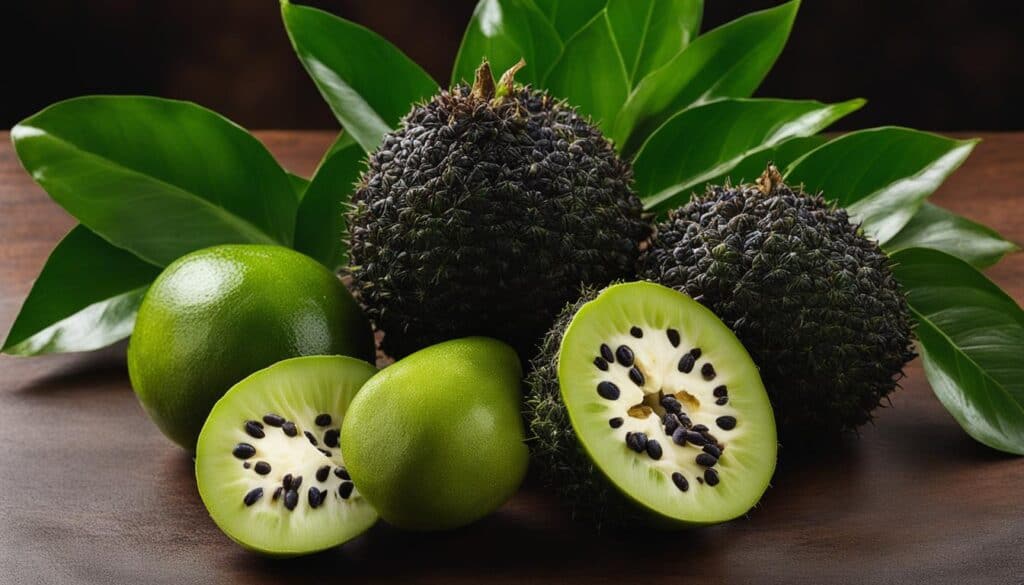
Table: Atemoya Flavor Profile
| Flavor | Taste |
|---|---|
| Sweetness | Deliciously sweet, with a perfect balance |
| Tanginess | Subtle tanginess that adds a refreshing twist |
| Pineapple | Hints of tropical pineapple flavor |
| Vanilla | Subtle undertones of vanilla |
| Creaminess | Smooth and custard-like texture |
As you can see from the flavor profile table, atemoya offers a delightful combination of sweet, tangy, pineapple, and vanilla flavors. These flavors, combined with the creamy and custard-like texture, make atemoya a truly exquisite fruit that is worth exploring.
So, if you’re looking to tantalize your taste buds and indulge in a tropical treat, give atemoya a try. Its unique flavor profile and creamy texture are sure to leave you craving for more.
How to Tell When Atemoya is Ripe
Determining the ripeness of an atemoya fruit is essential to ensure optimal flavor and texture. Here are a few indicators to look for:
- Color Change: A ripe atemoya will exhibit a change in color from green to a light yellowish or creamy tone. This transformation indicates that the fruit has reached its peak ripeness.
- Skin Texture: Gently press the skin of the atemoya. If it yields slightly and has a slight give, it is a sign that the fruit is ripe. Avoid fruits that feel too firm or excessively soft.
- Scent: Ripe atemoya fruits emit a sweet, fragrant aroma. If you notice a pleasant scent coming from the fruit, it is an excellent indication of its ripeness.
By considering these factors, you can ensure that your atemoya fruit is at its best when consumed.
Additional Tips:
If you are unsure about the ripeness of an atemoya, you can also perform a taste test. Cut a small piece of the fruit and taste it to evaluate its sweetness and overall flavor. Additionally, it may be helpful to consult with local farmers or experts who are familiar with atemoya cultivation in your region.
“The gentle press, the sweet scent, the creamy hue; these are the signs of a ripe atemoya ready to be enjoyed!”
Remember, the ripeness of atemoya can vary depending on the specific cultivar and growing conditions. It is always best to rely on a combination of visual cues, texture, and aroma to determine the optimum ripeness of the fruit. Enjoy the refreshing taste and delightful texture of a perfectly ripe atemoya!
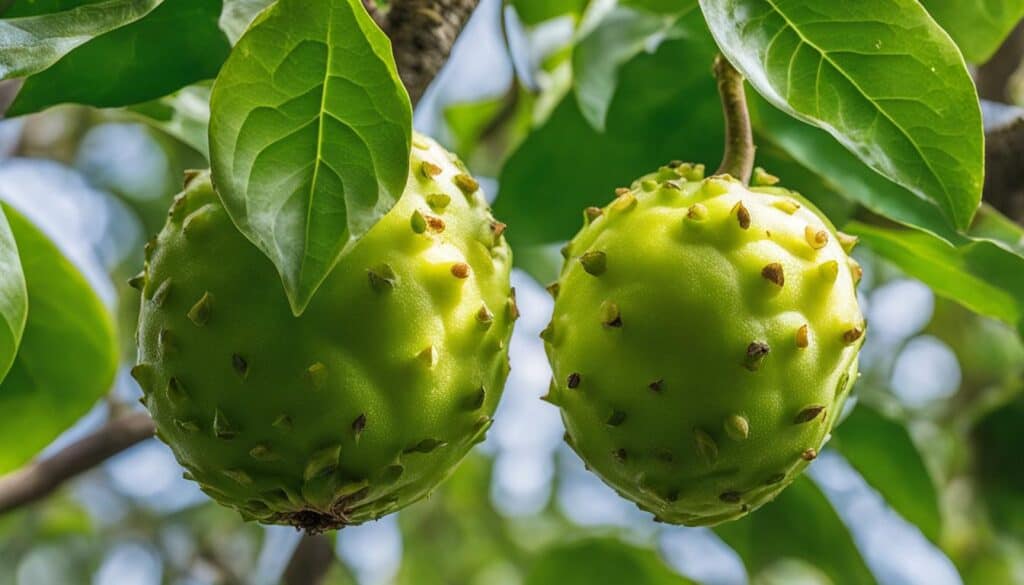
Atemoyas and Cherimoyas: Similarities and Differences
When it comes to tropical fruits, atemoyas and cherimoyas are two popular choices. Both belong to the Annonaceae family and share similarities in their overall shape and size. However, there are distinct differences between these fruits that set them apart.
Similarities:
- Belong to the Annonaceae family
- Round or heart-shaped fruit
- Sweet and creamy flavor
Differences:
Atemoyas are hybrid fruits resulting from a cross between cherimoya and sugar apple, while cherimoyas are a distinct fruit species. This hybrid origin gives atemoyas their unique characteristics. When comparing the two fruits, several differences become apparent:
| Atemoyas | Cherimoyas | |
|---|---|---|
| Fruit Skin Texture | Atemoyas typically have smoother and more bumpy skin | Cherimoyas have a more textured and scaly skin |
| Flavor Variations | Atemoyas have a sweet and tangy flavor profile with hints of pineapple, vanilla, and pear | Cherimoyas have a more complex taste with hints of vanilla, mango, and pear |
| Seed Size and Quantity | Atemoyas have more extensive and abundant seeds | Cherimoyas have smaller and fewer seeds |
| Availability and Cultivation | Atemoyas are more widely cultivated and available in different regions | Cherimoyas are grown in more limited areas |
These differences in skin texture, flavor, seed characteristics, and availability make atemoyas and cherimoyas unique in their own right. Both fruits offer a delightful taste experience and can be enjoyed in various culinary preparations, highlighting their tropical flavors and versatility. Whether you prefer the smoothness of atemoyas or the textured richness of cherimoyas, both fruits are sure to satisfy your taste buds.
Cooking with Atemoya
Atemoya is not only delicious to eat on its own, but it can also be used in a variety of culinary creations. From refreshing smoothies to delectable desserts, here are some enticing recipes that will make the most of this tropical fruit:
Atemoya Smoothie: Blend the pulp of a ripe atemoya with yogurt, milk, and a drizzle of honey for a refreshing and nutritious smoothie. The creamy texture and tropical flavors of the atemoya will make this a delightful treat.
Atemoya Sorbet: Create a delightful sorbet by blending the atemoya pulp with a simple syrup made from sugar and water, adding a squeeze of fresh lemon juice. Freeze the mixture until it reaches a firm consistency, and enjoy the creamy, fruity flavors of this refreshing dessert.
“Atemoya is a versatile fruit that can be used in both sweet and savory dishes. Its unique flavor profile adds a delightful twist to traditional recipes.”
Atemoya Salsa: Combine diced atemoya with finely chopped onion, jalapeño, and cilantro. Squeeze in some fresh lime juice and season with a pinch of salt for a tangy and tropical salsa that pairs perfectly with grilled fish or chicken.
Atemoya Upside-Down Cake: Put a tropical twist on a classic dessert by substituting atemoya for pineapple in an upside-down cake recipe. The creamy texture of the atemoya blends perfectly with the caramelized sugar topping, creating a heavenly treat.
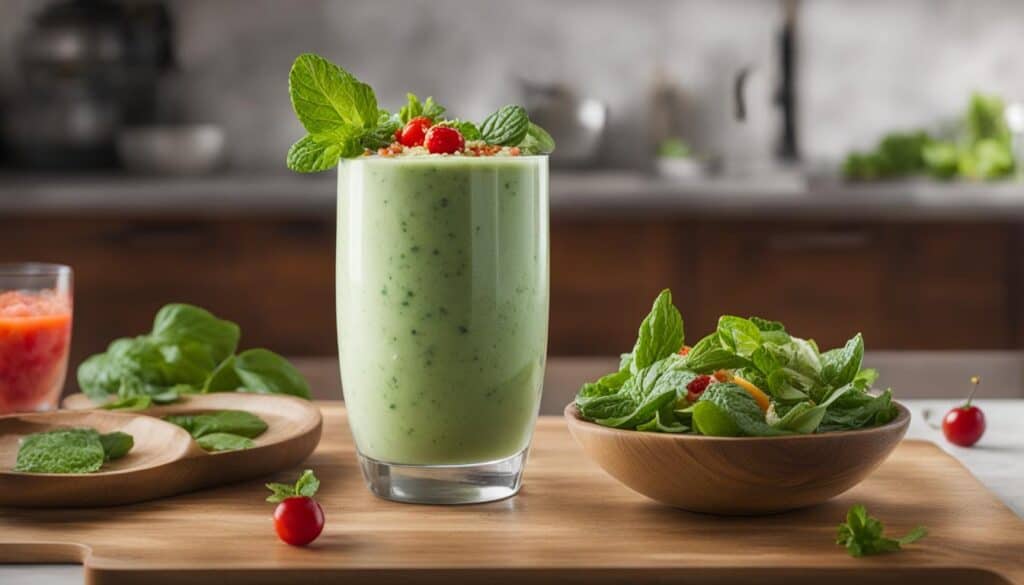
Table: Atemoya Cooking Ideas
| Recipe | Description |
|---|---|
| Atemoya Smoothie | Blend atemoya pulp with yogurt, milk, and honey for a refreshing smoothie. |
| Atemoya Sorbet | Create a fruity sorbet by blending atemoya pulp with a simple syrup and lemon juice, then freezing the mixture. |
| Atemoya Salsa | Combine diced atemoya with onion, jalapeño, cilantro, lime juice, and salt for a tangy salsa. |
| Atemoya Upside-Down Cake | Use atemoya instead of pineapple in an upside-down cake recipe for a tropical twist. |
How to Store Atemoya
Proper storage is essential to maintain the freshness and quality of atemoya. Whether you have freshly harvested atemoya from your own tree or purchased ripe ones from the market, here are some storage tips to help you prolong their shelf life and enjoy their tropical goodness:
Counter Storage:
If your atemoya is still unripe and needs time to ripen, store it at room temperature on the counter. Place the fruit in a well-ventilated area away from direct sunlight. Check the atemoya daily and wait until the skin turns a light yellowish or creamy color and it gives a slight give when gently pressed. Once ripe, proceed to the next storage option to preserve its freshness.
Refrigerator Storage:
Ripe atemoya should be refrigerated to slow down the ripening process and extend its shelf life. Wrap the fruit loosely in plastic or place it in a plastic bag to prevent moisture loss. Keep it in the refrigerator’s fruit or vegetable compartment, which maintains a temperature between 41°F (5°C) and 50°F (10°C). Ripe atemoya can last for about 3-5 days when stored properly in the fridge.
Freezing Atemoya:
If you have a surplus of ripe atemoya and want to preserve them for longer, freezing is an option. To freeze atemoya, first remove the skin and seeds. Cut the fruit into small pieces or slices. Place the prepared atemoya in a freezer-safe bag or container, ensuring it is tightly sealed to prevent freezer burn. Frozen atemoya can last for several months, but it’s best to consume them within 6 to 8 months for the best quality.
By following these storage methods, you can enjoy the delectable taste of atemoya even beyond its natural season. Remember to always consume ripe atemoya promptly or store them appropriately to savor their sweet and tangy flavors.
| Storage Method | Duration | Temperature |
|---|---|---|
| Counter Storage | Until ripened | Room temperature |
| Refrigerator Storage | 3-5 days | 41°F (5°C) to 50°F (10°C) |
| Freezing Atemoya | Several months | Below 0°F (-18°C) |
Nutritional Benefits of Atemoya
When it comes to nutrition, atemoya is a powerhouse fruit. It offers a wide range of health benefits that make it a valuable addition to any diet. One of the key nutrients found in atemoya is vitamin C. This essential vitamin plays a crucial role in supporting the immune system, promoting collagen synthesis, and aiding in the absorption of iron.
In addition to vitamin C, atemoya is also rich in dietary fiber. Fiber is known for its role in promoting healthy digestion and preventing constipation. It can also help lower cholesterol levels and regulate blood sugar levels. Including atemoya in your diet can provide you with a good source of dietary fiber to support your overall well-being.
Furthermore, atemoya contains important minerals such as calcium and iron. Calcium is essential for maintaining strong bones and teeth, while iron is necessary for oxygen transport in the body. By incorporating atemoya into your meals or snacks, you can boost your intake of these vital minerals and support your overall health.
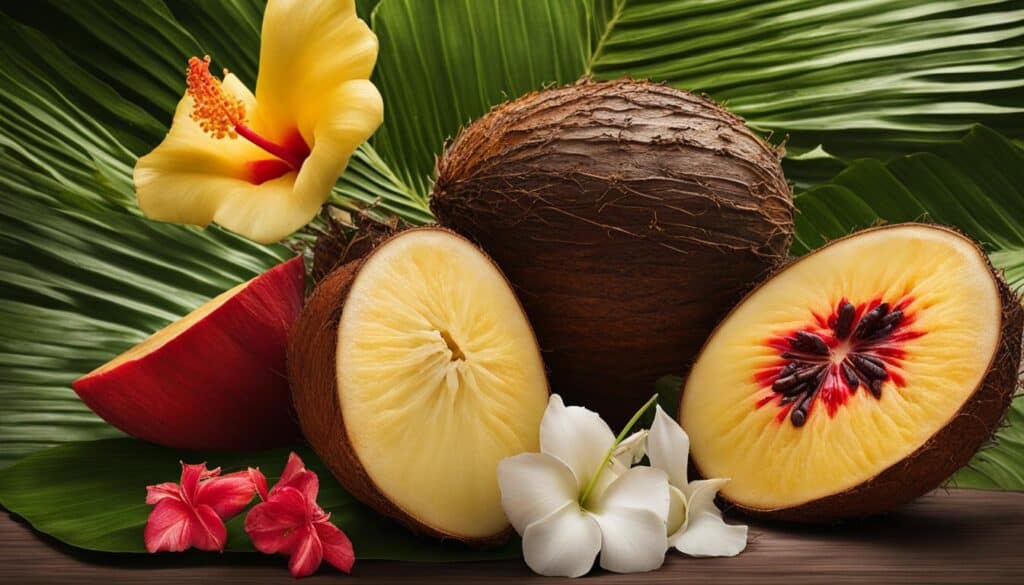
| Nutrient | Amount per 100g |
|---|---|
| Vitamin C | 24.9mg |
| Dietary Fiber | 3.2g |
| Calcium | 11mg |
| Iron | 0.26mg |
Table: Nutritional content of atemoya per 100g
With its impressive nutrient profile, atemoya not only tantalizes your taste buds but also provides your body with essential vitamins, minerals, and fiber. So why not embrace the goodness of atemoya and enjoy its tropical flavor while reaping its nutritional benefits?
Conclusion
After delving into the world of atemoya, I am captivated by this unique tropical fruit. Its refreshing taste and health perks make it a remarkable addition to any diet. Whether enjoyed raw or used in various culinary creations, atemoya’s tropical flavor profile is sure to delight the taste buds.
In addition to its delectable taste, atemoya offers an array of health benefits. Packed with vitamin C, it supports the immune system and aids in collagen synthesis. The presence of dietary fiber aids in digestion and helps maintain healthy cholesterol levels. Atemoya also provides essential minerals such as calcium, important for strong bones and teeth, and iron, which plays a vital role in oxygen transport.
Originating in Central America, atemoya has traversed different regions, gaining popularity worldwide. Its journey reflects its growing appreciation and recognition among fruit enthusiasts. Embracing the atemoya is an invitation to experience the wonders of tropical flavors and natural goodness.
FAQ
Q: What is the history of Atemoya?
A: Atemoya was created by horticulturist P.J. Wester in a USDA laboratory in Miami in 1908. It is a hybrid fruit resulting from a cross between the sugar apple and the cherimoya. The first atemoya hybrids were considered even better than the sugar apple. The atemoya was introduced to the Philippines and from there, it spread to South America, Hawaii, Israel, Australia, New Zealand, South Africa, and Egypt. It was cultivated in different regions and gained popularity along its journey.
Q: What does Atemoya taste like?
A: Atemoya has a unique flavor profile that combines the sweet and tangy notes of the cherimoya with hints of pineapple, vanilla, and pear. It offers a delightful balance of sweetness and acidity. The flesh of the atemoya is creamy and custard-like, with a smooth texture. It is often described as a tropical delicacy due to its distinct flavors and texture.
Q: How can I tell when Atemoya is ripe?
A: To determine if an atemoya fruit is ripe, look for a change in color from green to a light yellowish or creamy tone. The skin should have a slight give when gently pressed. The texture of a ripe atemoya should feel slightly soft and smooth to the touch. Ripe atemoya fruits emit a sweet, fragrant aroma. If the fruit has a pleasant smell and the desired characteristics mentioned above, it is likely ripe.
Q: What are the similarities and differences between Atemoyas and Cherimoyas?
A: Atemoyas and cherimoyas belong to the same botanical family, Annonaceae. They have similar overall shapes and sizes, with round or heart-shaped fruit. Both fruits have a sweet and creamy flavor, although cherimoyas are generally considered to have a more complex taste with hints of vanilla, mango, and pear. Atemoyas are hybrid fruits resulting from a cross between cherimoya and sugar apple, while cherimoyas are a distinct fruit species. Atemoyas typically have smoother and more bumpy skin than cherimoyas. Atemoyas also have more extensive and abundant seeds compared to cherimoyas. Atemoyas are more widely cultivated and available in different regions, while cherimoyas are grown in more limited areas.
Q: How can I use Atemoya in cooking?
A: Atemoya can be used in various culinary preparations. It can be consumed raw or used in recipes such as smoothies, sorbets, salsas, and even desserts like upside-down cake. Atemoya smoothies can be made by blending the pulp with yogurt, milk, and honey. Atemoya sorbet can be created by blending the pulp with a simple syrup and lemon juice, then freezing the mixture. Atemoya salsa can be made by mixing diced atemoya with onion, jalapeño, cilantro, lime juice, and salt. Atemoya upside-down cake can be made by substituting atemoya for pineapple in a traditional recipe.
Q: How should I store Atemoya?
A: Atemoya is a perishable fruit and should be stored properly. Ripe atemoya can be stored on the counter until it becomes slightly soft with a yellowish or creamy skin. Once ripe, it should be consumed or refrigerated immediately to extend its shelf life. Ripe atemoya can last for about 3-5 days when stored in the refrigerator. It should be placed in a plastic bag or loosely wrapped in plastic to prevent moisture loss. Atemoya can also be frozen for long-term storage by removing the skin and seeds, cutting the fruit into pieces, and storing it in a freezer-safe bag or container.
Q: What are the nutritional benefits of Atemoya?
A: Atemoya is not only delicious but also packed with nutrients. It is rich in vitamin C, which supports the immune system, promotes iron absorption, and contributes to collagen synthesis. Atemoya is also a good source of dietary fiber, which aids in digestion and helps lower cholesterol levels. It contains some calcium for strong bones and teeth, as well as iron for oxygen transport in the body.

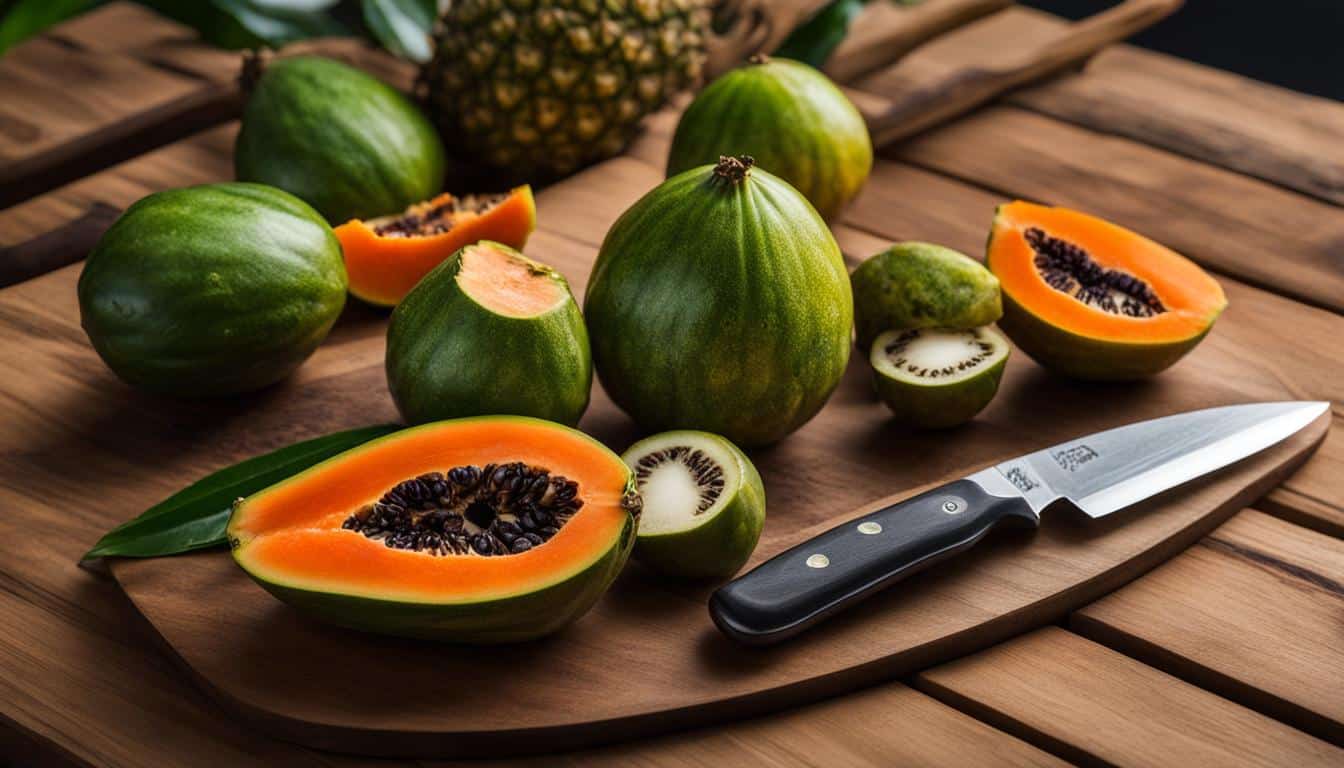



Leave a Reply